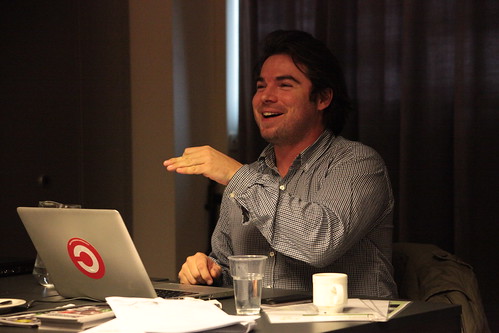The pre-conference in Hilversum provided a stage for Dolf Veenvliet as member of the Blender Organization, and Jamie King of the P2P sharing platform VODO to talk about the commons, crowdfunding, and the community. The two presentations provided a perfect showcase of how open standards can provide a platform for creating and distributing content.

The Blender Organization used the free open source 3D content creation suite Blender for creating a 3D animation. Sintel is a independently produced short film, initiated by the Blender Foundation as a means to further improve and validate the Blender application. The project was funded by donations from the community and several financial film funds in The Netherlands.
The Blender community is really involved and are eager to contribute to the application, the community itself, and the ongoing projects. Not only in a financial sense by funding the production, but also by providing models when the team didn’t had the resources to create them themselves. Dolf Veenvliet is confident that people are willing to invest in cool projects and are willing to get involved; crowdfunding is the new way for creating a production.

The Sintel team involved the community by giving away stuff for free, such as models used in the movie, and by keeping the community updated about the progress. In exchange they asked the community to create models to use in the film. Although the quality of the models varied, the community got really involved by having a change to make it into the final credits. Another important aspect of the Sintel project was the fact that everything was done for free. As Veenvliet notes, when you do things for free, people give you free stuff as well.
A community is needed before you can ask for investments and crowdfunding, and not the other way around. By doing so the community is willing to contribute in the form of funds, models, and more importantly promotion. Sintel is distributed over the Internet using different channels of which some are initiated by the community. You can watch the movie on YouTube (over 1 million views), but to download the file the Blender Foundation reached out to the BitTorrent network. BitTorrent is the perfect P2P technology for the free distribution of large files.
This is where VODO comes in. VODO.net is a platform which allows users to make donations for a film in exchange for extra access and material. The concept deviates from the traditional distribution system by offering the movie for free using the BitTorrent protocol and asking the community for donations. For example the movie The Yes Man Fix the World made 33.000 thousand dollars in 6 weeks and 1 million people downloaded the movie. This was after its initial success in theaters and festivals around the world.

Jamie King gives several reasons for the success of the concept. First of all it involves social distribution. Bandwith bills are none because it is using domestic internet connections by using the BitTorrent protocol so the distribution costs are zero. Secondly, the concept of crowdfunding asks for donations but offers the movie for free. And finally, the crowd is being reached by using the same channels such as PirateBay and IsoHunt. By rewarding the community on VODO if they promote a production it creates value for both the producer and the consumers.
There are however some remarks. At the moment crowdsourcing or crowdfunding is still too small for full-length animation movies. Also, crowd sourcing usually only provides you an income after completion. Although Sintel was able to raise money beforehand, it’s difficult to create a community who’s is willing to fund a project which still has to be made. Both presenters acknowledge this is easier after your first success and you created a community. For this reason VODO is creating an auction function on their website which allows producers to get funding in exchange for a stake in the work. A concept which is successfully applied by SellaBand.Jamie King sees VODO as an alternative for traditional movie production and video distribution which taps right into the core of the other presentation during the pre-conference.


